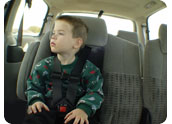TRANSPORTATION / MOTOR VEHICLE INFORMATION
Driver License
Once you have established residency in Connecticut, you have 30 days to transfer your out-of-state license. Applicants must provide their current out-of-state license, which must be surrendered at the time a Connecticut license is issued. Another form of acceptable identification will be required, usually a legal birth certificate. Those who are not U.S. citizens must prove legal status. New residents must verify their current address in the form of a utility bill, mortgage document, or rental agreement. The social security number of all applicants is recorded on the application for a non-commercial driver license.
Even applicants with valid licenses from another state will need to take the vision test. Those who are holding of out-of-state licenses that have expired beyond 60 days will have to take all Connecticut tests. If you have lost your license, present a letter of verification from your previous state of residence stating that you have a current license from that state. Connecticut does not accept driver licenses that were issued to individuals who are under 16 years of age. New residents under 18 years of age must submit an out-of-state certificate stating the number of hours of training that meets or exceeds the state’s 30 hours of classroom instruction and eight hours of behind-the-wheel training. Assistance with locating the nearest full-service or branch licensing office can be obtained from the Department of Motor Vehicles.
Vehicle Registration
Transferring registration on an out-of-state vehicle must be accomplished within 60 days of establishing state residency in Connecticut. An emissions test and Vehicle Identification Number (VIN) verification will both be required. You must first take your vehicle to one of the state’s vehicle emissions testing stations. A number of highly automated inspection stations are conveniently located throughout the state. Once the test is complete and the fee is paid, a sticker is applied to the windshield. You will then be given a report to present to the Department of Motor Vehicles to complete your vehicle registration. Proceed to your local DMV branch office to submit your out-of-state certificate of title and motor vehicle registration certificate. If a lien holder has the title, submit a photocopy. Bring the emissions test report that was given to you at the emissions test station and complete the application for registration and certificate of title. You will also need a current Connecticut insurance identification card, which can be obtained from your Connecticut-licensed insurance company. (For leased cars, the insurance card may be in the name of the lessee.)
The Department of Revenue Services requires that the sales tax information and/or purchase price be included on the application form. Full trade-in credit is allowed when computing the Connecticut sales tax if the vehicle is purchased from a licensed dealer. New Connecticut residents will not be required to pay sales tax if the vehicle was registered in another state for at least 30 days prior to the establishment of Connecticut residency.
Safety inspections are required for certain older vehicles and other special-category vehicles. If your vehicle is one that requires inspection, you will find safety inspection facilities located in Enfield, Hamden, and Wethersfield. For further assistance or answers to specific questions, contact:
Department of Motor Vehicles
860-263-5700
800-842-8222
www.ct.gov/dmv
Connecticut Emissions Program
888-828-8399
www.ctemissions.com
Seat Belt Law
Drivers and front-seat passengers as well as all rear-seat passengers from ages 4 to 16 are required by law to wear seat belts. The driver of the vehicle is subject to a fine for noncompliance. Children under the age of four years who weigh less than 40 pounds are also required to be properly secured in a federally approved child restraint system. Any children above the age of four years and weighing 40 or more pounds must be provided with an approved child restraint system or be required to use a seat belt. Positioning an infant in a federally approved car seat in the rear seat of the vehicle—with the child facing the back seat, not the front seat—provides the best possible protection. Statistically, the safest place in the vehicle for all children is the rear seat.


